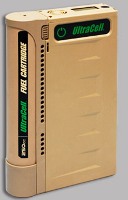Why do we need alternative energy?
Powering sensors by alternative energy means that
you are not only saving energy from the grid, but you can place your sensors in remote locations. This applies easily
to field situations where there is no grid power available, but also to the backside of an airfield, on a pole in
the middle of a parking lot where you would have an expensive trenching and repaving job to provide power. Many
times we must combine one or more energy sources to meet the needs of the device.
The heart of most systems will
be a battery. If we need only a short term solution, a battery alone may handle the the sensor's need for a few
hours to a few days. We are constantly evaluating the latest battery chemistry to insure we are minimizing weight and
size while maximizing the amount of available power. In a multi-resource system where the device may have various dependencies
on the environment, such as wind velocity, sun exposure or water flow, the battery can act as a buffer and storage device
for lulls in energy production. Using solar as an example, a battery would supply energy through the night until
the photovoltaic is producing again.
Fuel cells have been in the news and talked about for the past several years.
Current fuel cell technology is limited by capacity and fuel availability. Fortunately, while fuel cell technology continues
to develop, sensor technology does as well. Today's sensors and wireless radios are becoming much more energy efficient.
We have been successful running cameras for over two weeks with a fuel cell that runs on a methanol and water mixture.
At just 25 watts we are able to match a day/night camera and a wireless radio to fully function with that particular fuel
cell.
Photovoltaic, or the more common term, solar cells, are the most popular in areas where we have several hours
of sun. This is a wonderful source of energy if you have access to the sun, high latitudes or under a jungle canopy
make things difficult. Glass or durable stainless steel backed panels are ideal for stationary or mobile based units.
A solar array, complete with tower for sensors, can be mounted on a trailer and positioned where needed. Advancements
in fold up technology are making man packable solutions very viable. In most cases a solar solution will require a battery
bank to insure operation through the evening hours and cloudy days.
Wind and water depend on the flow of the medium
to produce energy. This is an excellent source of energy if the wind or water are there constantly. Rivers and
streams can provide a reliable source while wind will depend more on the geography and location. Mountain tops and passes
may only have good winds a few months of the year. Weather fronts can calm winds or enhance them. A local environment
can cause "dirty" or turbulent air that is less effective on wind turbines. Buildings, trees, shrubs, and
hills are a few of the things that can impact the laminar flow of the air. It is not always as simple as just erecting
a system and walking away.
Alternative energy is an important consideration in designing and implementing a surveillance
system. It's important to address the strong and weak points of different options. Fourwinds is a proven
expert in the applications of alternative energy. We will evaluate your mission, location and environment, and we'll develop
a solution that will ensure the best operation of your sensors.
| Photovoltaic Power Plants |

|
| Click on picture |
| Fuel Cell Technology |

|
| Click on picture |
| Wind Power |

|
| Click on picture |

|
| Click on picture |